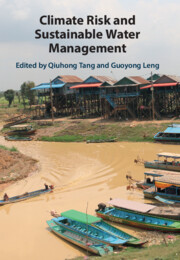Book contents
- Climate Risk and Sustainable Water Management
- Climate Risk and Sustainable Water Management
- Copyright page
- Contents
- Contributors
- Preface
- Acknowledgements
- Part I Water-Related Risks under Climate Change
- Part II Climate Risk to Human and Natural Systems
- 7 Observed Urban Effects on Temperature and Precipitation in Southeast China
- 8 Vegetation Dynamics, Land Use and Ecological Risk in Response to NDVI and Climate Change in Nepal
- 9 Climate Warming Induced Frozen Soil Changes and the Corresponding Environmental Effect on the Tibetan Plateau
- 10 A Review of the Effects of Climate Extremes on Agriculture Production
- 11 Agricultural Water Use Estimation and Impact Assessment on the Water System in China
- 12 Impact of Inter-Basin Water Transfer on Water Scarcity in Water-Receiving Area under Global Warming
- 13 Broadening and Deepening the Rainfall-Induced Landslide Detection
- 14 Estimating Aquifer Depth in Arid and Semi-arid Watersheds using Statistical Modelling of Spectral MODIS Products
- Part III Sustainable Water Management under Future Uncertainty
- Index
- References
9 - Climate Warming Induced Frozen Soil Changes and the Corresponding Environmental Effect on the Tibetan Plateau
A Review
from Part II - Climate Risk to Human and Natural Systems
Published online by Cambridge University Press: 17 March 2022
- Climate Risk and Sustainable Water Management
- Climate Risk and Sustainable Water Management
- Copyright page
- Contents
- Contributors
- Preface
- Acknowledgements
- Part I Water-Related Risks under Climate Change
- Part II Climate Risk to Human and Natural Systems
- 7 Observed Urban Effects on Temperature and Precipitation in Southeast China
- 8 Vegetation Dynamics, Land Use and Ecological Risk in Response to NDVI and Climate Change in Nepal
- 9 Climate Warming Induced Frozen Soil Changes and the Corresponding Environmental Effect on the Tibetan Plateau
- 10 A Review of the Effects of Climate Extremes on Agriculture Production
- 11 Agricultural Water Use Estimation and Impact Assessment on the Water System in China
- 12 Impact of Inter-Basin Water Transfer on Water Scarcity in Water-Receiving Area under Global Warming
- 13 Broadening and Deepening the Rainfall-Induced Landslide Detection
- 14 Estimating Aquifer Depth in Arid and Semi-arid Watersheds using Statistical Modelling of Spectral MODIS Products
- Part III Sustainable Water Management under Future Uncertainty
- Index
- References
Summary
Climate change caused by the increase in regional and global air temperature significantly affects the environment, especially in cold regions. The frozen ground degradation and its environmental consequence in the Tibetan region are reviewed. Model simulations show that air temperature in the Tibetan Plateau will continue to increase by 3.8–4.8°C at the end of this century. From 1981 to 2010, the duration of seasonally frozen ground was shortened, which delayed its start by 3.4 days and ended 9.4 days earlier than normal. The warming phenomenon resulted in degradation of frozen ground and permafrost by 3.3 105 km2 and 1.11 106 km2, respectively. From 2001 to 2015,soil erosion and desert area increased by 1.14 and 1.80 per cent, respectively. This resulted in a reduction of vegetation coverage. In addition, the influence of climate change on highway on the Qinghai–Tibetan Plateau was also caused by frozen ground degradation, soil deformation and thawed settlement. With a large portion of frozen ground degradation in the Qinghai–Tibetan Plateau, long-term field monitoring, remote sensing investigations, model predictions for temperature and frozen soil, and adaptations to environmental change are needed to mitigate the effects of more intense changes expected in the future.
Keywords
- Type
- Chapter
- Information
- Climate Risk and Sustainable Water Management , pp. 179 - 197Publisher: Cambridge University PressPrint publication year: 2022

